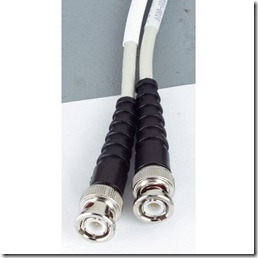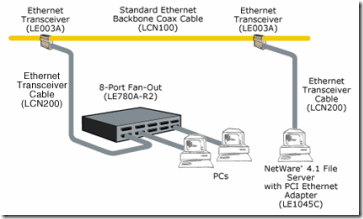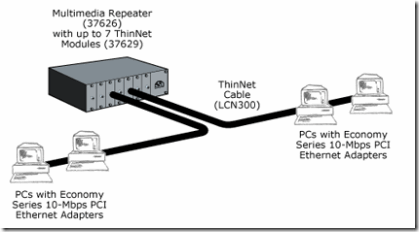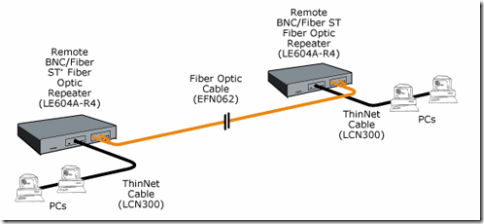 --> (Word) --> (Word) |  --> (PDF) --> (PDF) |  --> (Epub) --> (Epub) |
| This article has been published [fromdate] | ||
If you have an existing network, there’s a 90% chance it’s Ethernet. If you’re installing a new network, there’s a 98% chance it’s Ethernet— the Ethernet standard is the overwhelming favorite network standard today.
Ethernet was developed by Xerox®, DEC™, and Intel® in the mid-1970s as a 10-Mbps (Megabits per second) networking protocol—very fast for its day—operating over a heavy coax cable (Standard Ethernet).
Today, although many networks have migrated to Fast Ethernet (100 Mbps) or even Gigabit Ethernet (1000 Mbps), 10-Mbps Ethernet is still in widespread use and forms the basis of most networks.
Ethernet is defined by international standards, specifically IEEE 802.3. It enables the connection of up to 1024 nodes over coax, twisted-pair, or fiber optic cable. Most new installations today use economical, lightweight cables such as Category 5 unshielded twisted-pair cable and fiber optic cable.
How Ethernet Works
Ethernet signals are transmitted from a station serially, one bit at a time, to every other station on the network.
Ethernet uses a broadcast access method called Carrier Sense Multiple Access/Collision Detection (CSMA/CD) in which every computer on the network “hears” every transmission, but each computer “listens” only to transmissions intended for it.
Each computer can send a message anytime it likes without having to wait for network permission. The signal it sends travels to every computer on the network. Every computer hears the message, but only the computer for which the message is intended recognizes it. This computer recognizes the message because the message contains its address. The message also contains the address of the sending computer so the message can be acknowledged.
If two [gs computer]s send messages at the same moment, a “collision” occurs, interfering with the signals. A computer can tell if a collision has occurred when it doesn’t hear its own message within a given amount of time. When a collision occurs, each of the colliding computers waits a random amount of time before resending the message.
The process of collision detection and retransmission is handled by the Ethernet adapter itself and doesn’t involve the computer. The process of collision resolution takes only a fraction of a second under most circumstances. Collisions are normal and expected events on an Ethernet [gs network]. As more computers are added to the network and the traffic level increases, more collisions occur as part of normal operation. However, if the network gets too crowded, collisions increase to the point where they slow down the network considerably.
[tab:10BASE5]
Standard (Thick) Ethernet (10BASE5)
- Uses “thick” coax cable with N-type connectors for a backbone and a transceiver cable with 9-pin connectors from the transceiver to the NIC.
- Both ends of each segment should be terminated with a 50-ohm resistor.
- Maximum segment length is 500 meters.
- Maximum total length is 2500 meters.
- Maximum length of transceiver cable is 50 meters.
- Minimum distance between transceivers is 2.5 meters.
- No more than 100 transceiver connections per segment are allowed.
[tab:10BASE2]
Thin Ethernet (ThinNet) (10BASE2)
- Uses “Thin” coax cable.
- The maximum length of one segment is 185 meters.
- The maximum number of segments is five.
- The maximum total length of all segments is 925 meters.
- The minimum distance between T-connectors is 0.5 meters.
- No more than 30 connections per segment are allowed.
- T-connectors must be plugged directly into each device.
[tab:10BASE-T]
Twisted-Pair Ethernet (10BASE-T)
- Uses 22 to 26 AWG unshielded twisted-pair cable (for best results, use Category 4 or 5 unshielded twisted pair).
- The maximum length of one segment is 100 meters.
- Devices are connected to a 10BASE-T hub in a star configuration.
- Devices with standard AUI connectors may be attached via a 10BASE-T transceiver.
[tab:10BASE-FL]
Fiber Optic Ethernet (10BASE-FL, FOIRL)
- Uses 50-, 62.5-, or 100-micron duplex multimode fiber optic cable (62.5 micron is recommended).
- The maximum length of one 10BASE-FL (the new standard for fiber optic connections) segment is 2 kilometers.
- The maximum length of one FOIRL (the standard that preceded the new 10BASE-FL) segment is 1 kilometer.
[tab:END]
SOURCE | LINK (Cpcstech.com)
| LANGUAGE | ENGLISH |
 | |||





